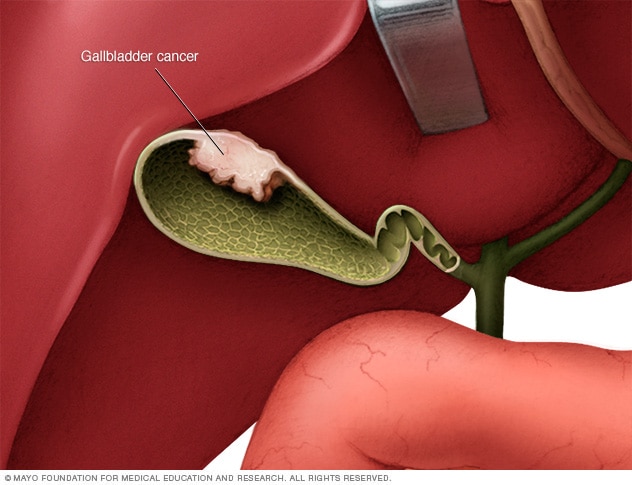Gallbladder cancer
Gallbladder cancer
overview
Gallbladder cancer

Gallbladder cancer
Gallbladder cancer begins in the cells of the gallbladder. Your gallbladder is a small, pear-shaped organ on the right side of your abdomen, just below your liver.
Gallbladder cancer is an abnormal growth of cells that begins in the gallbladder.
Your gallbladder is a small, pear-shaped organ on the right side of your abdomen, just below your liver. The gallbladder stores bile, a digestive fluid produced by your liver.
Gallbladder cancer is rare. If gallbladder cancer is discovered in its early stages, the chances of recovery are very good. But most gallbladder cancers are discovered at a late stage, when the prognosis is often very poor.
Gallbladder cancer may not be discovered until it is advanced because it often does not cause any specific signs or symptoms. Additionally, the relatively hidden nature of the gallbladder makes it easier for gallbladder cancer to grow without being detected.
Symptoms
Signs and symptoms of gallbladder cancer may include:
- Bauchschmerzen, besonders im rechten Oberbauch
- Blähungen
- Abnehmen ohne es zu versuchen
- Gelbfärbung der Haut und des Augenweiß (Gelbsucht)
When to go to the doctor?
Make an appointment with your doctor if you notice any signs or symptoms that worry you.
Causes
Gallbladder and bile duct

Gallbladder and bile duct
The gallbladder serves as a reservoir for a yellow-green fluid produced in your liver (bile). Bile flows from your liver into your gallbladder, where it is held until needed during the digestion of food. When you eat, your gallbladder releases bile into the bile duct, where it is transported to the upper part of the small intestine (duodenum) to help break down fat in food.
It's not clear what causes gallbladder cancer.
Doctors know that gallbladder cancer occurs when healthy gallbladder cells develop changes (mutations) in their DNA. A cell's DNA contains the instructions that tell a cell what to do. The changes tell the cells to get out of control and continue living when other cells would normally die. The accumulating cells form a tumor that can grow beyond the gallbladder and spread to other areas of the body.
Most gallbladder cancers begin in the glandular cells that line the inner surface of the gallbladder. Gallbladder cancer that begins in this cell type is called adenocarcinoma. This term refers to the way the cancer cells look when examined under a microscope.
Risk factors
Factors that may increase the risk of gallbladder cancer include:
- Ihr Geschlecht. Gallenblasenkrebs tritt häufiger bei Frauen auf.
- Ihr Alter. Ihr Risiko für Gallenblasenkrebs steigt mit zunehmendem Alter.
- Eine Geschichte von Gallensteinen. Gallenblasenkrebs tritt am häufigsten bei Menschen auf, die Gallensteine haben oder in der Vergangenheit Gallensteine hatten. Größere Gallensteine können ein größeres Risiko tragen. Dennoch sind Gallensteine sehr häufig und selbst bei Menschen mit dieser Erkrankung ist Gallenblasenkrebs sehr selten.
- Andere Erkrankungen und Zustände der Gallenblase. Andere Erkrankungen der Gallenblase, die das Risiko für Gallenblasenkrebs erhöhen können, sind Polypen, chronische Entzündungen und Infektionen.
- Entzündung der Gallenwege. Primär sklerosierende Cholangitis, die eine Entzündung der Gänge verursacht, die die Galle aus der Gallenblase und der Leber ableiten, erhöht das Risiko für Gallenblasenkrebs.
Gallbladder cancer treatment
Sources:
- Niederhuber JE, et al., Hrsg. Leber- und Gallengangskrebs. In: Abeloffs Klinische Onkologie. 6. Aufl. Elsevier; 2020. https://www.clinicalkey.com. Abgerufen am 5. August 2020.
- Feldman M. et al., Hrsg. Tumore der Gallengänge, der Gallenblase und der Ampulle. In: Gastrointestinale und Lebererkrankungen von Sleisenger und Fordtran: Pathophysiologie, Diagnose, Management. 11. Aufl. Elsevier; 2021. https://www.clinicalkey.com. Abgerufen am 5. August 2020.
- Hepatobiliärer Krebs. Nationales umfassendes Krebsnetzwerk. https://www.nccn.org/professionals/physician_gls/default.aspx. Abgerufen am 5. August 2020.
- Warner KJ. Allscripts EPSi. Mayo-Klinik. 4. Juni 2020.

 Suche
Suche
 Mein Konto
Mein Konto